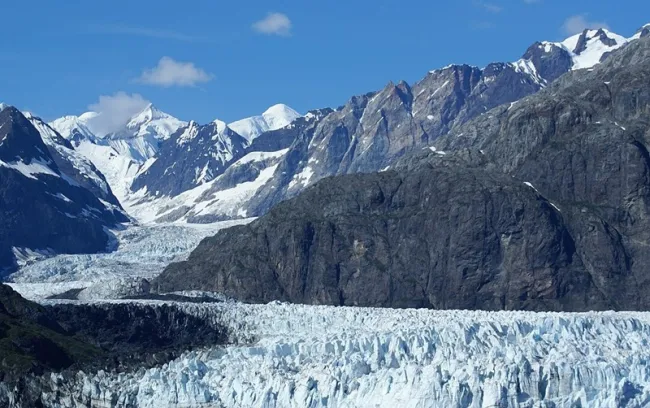
Glacier Bay National Park, located in southeastern Alaska, is a stunning example of raw, untamed wilderness. Spanning over 3.3 million acres, it is a part of the larger Glacier Bay Biosphere Reserve and UNESCO World Heritage Site. The park is renowned for its spectacular tidewater glaciers, rugged mountains, deep fjords, and a rich array of wildlife, making it a paradise for nature enthusiasts, adventurers, and photographers alike.
History of the Park
The history of Glacier Bay is closely tied to the movement of glaciers. Roughly 200 years ago, the entire bay was covered by ice, which has since receded, exposing land that has become an ecological treasure. The area was designated as a national monument in 1925 by President Calvin Coolidge and later became a national park in 1980 under the Alaska National Interest Lands Conservation Act. Glacier Bay has long been important to the Tlingit people, whose cultural ties to the land and waters persist to this day.
Main Features
The main features of Glacier Bay National Park include its tidewater glaciers, particularly the Margerie Glacier, which is one of the most iconic in the park. Visitors often witness the awe-inspiring sight of calving, where chunks of ice break off from the glacier and crash into the bay. The park is also home to the Fairweather Range, which boasts some of the tallest peaks in North America. In addition, Glacier Bay is rich in marine life, including humpback whales, orcas, sea otters, and seals, as well as land animals such as brown bears, moose, and mountain goats.
Types of Trails
While Glacier Bay is predominantly accessed via boat or air, there are several hiking trails that offer visitors the opportunity to explore the park’s rugged landscape. The Bartlett River Trail, at around 4 miles round-trip, leads hikers through lush forests to the banks of the Bartlett River. The Forest Loop Trail is a shorter, easier option that offers a 1-mile loop through the rainforest near Bartlett Cove. For those seeking a more challenging trek, the Mount Fairweather region offers off-the-beaten-path opportunities for experienced backcountry hikers.
Crowd Expectations and Annual Visitors
Glacier Bay National Park is relatively remote and receives fewer visitors than some of the more accessible national parks in the lower 48 states. Annually, the park sees approximately 500,000 visitors, many of whom arrive via cruise ships. While the park can feel bustling in the summer months, particularly in areas like Bartlett Cove, the vast wilderness allows for solitude in many other parts of the park.
Accessibility for Seniors and Wheelchairs
The park’s remoteness and terrain can make accessibility a challenge, but Glacier Bay does offer options for seniors and visitors with mobility challenges. The Bartlett Cove area, where the visitor center is located, provides wheelchair-accessible trails, including the Forest Loop Trail. The visitor center and nearby lodges are also equipped with accessible facilities. For those exploring the park by boat, certain tour operators accommodate wheelchairs, allowing for a close-up view of the glaciers and wildlife without extensive walking.
Park Amenities
Glacier Bay National Park offers several amenities, including a visitor center at Bartlett Cove, where visitors can learn about the park’s history, geology, and wildlife. The Glacier Bay Lodge, located near the visitor center, provides dining and accommodations. Boat tours, kayak rentals, and ranger-led programs are available for those looking to explore the park further. The park also features designated picnic areas, restrooms, and water stations.
Camping Facilities
Camping in Glacier Bay is a unique experience that allows visitors to immerse themselves in the wilderness. The Bartlett Cove Campground, located near the visitor center, is a free, walk-in campground with basic facilities, including bear-proof food storage, restrooms, and water access. Permits are required for backcountry camping, and campers must be well-prepared for the remote conditions, including wildlife safety measures.
Access to Lodging
Lodging within Glacier Bay National Park is limited to the Glacier Bay Lodge, which offers comfortable accommodations and stunning views of the bay. The lodge operates seasonally from mid-May to early September. Outside the park, additional lodging can be found in the nearby town of Gustavus, which is accessible by boat or plane. Gustavus offers a range of accommodations, from small inns to vacation rentals.
Pet-Friendliness
Due to the fragile ecosystem and the presence of wildlife, Glacier Bay National Park has strict regulations regarding pets. Pets are not allowed on trails, beaches, or in the backcountry, and must be kept on a leash at all times when in designated areas. Visitors traveling with pets should check with the park’s regulations before bringing animals into the park.
Best Months to Visit
The best time to visit Glacier Bay National Park is during the summer months, from mid-May to early September. During this time, the weather is milder, and the park is fully operational, with services such as boat tours, ranger programs, and lodging available. Wildlife is also more active during the summer, making it the ideal time for whale watching and other wildlife encounters. Early fall offers a quieter experience, though weather conditions can become unpredictable.
Conclusion
Glacier Bay National Park is a breathtaking destination that offers a unique blend of glacial scenery, wildlife, and wilderness adventure. Whether you’re exploring by boat, hiking the trails, or simply soaking in the views, the park offers an unforgettable experience for nature lovers and adventurers alike. With its rich history, diverse ecosystems, and remote beauty, Glacier Bay remains one of Alaska’s most prized natural wonders.



